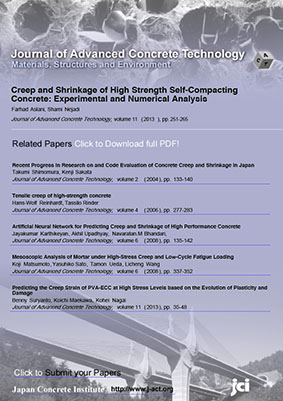
- |<
- <
- 1
- >
- >|
-
Teng Shuo, Kazumasa Okubo, Junichiro Niwa2019Volume 17Issue 9 Pages 506-517
Published: September 03, 2019
Released on J-STAGE: September 03, 2019
JOURNAL FREE ACCESSThis study is aimed at investigating the effects of stirrups on the shear behavior of RC tapered short beams. Static four-point bending tests were conducted to six RC tapered beams with various stirrup ratios and arrangements. Besides, nonlinear FEM analysis was also conducted to simulate the shear behavior and to confirm the properties of the inclined compressive strut. The results showed that the shear capacity and contribution of stirrups did not definitely increase with the increase in the stirrup ratio. Moreover, the condition of shear resistance mechanism varied due to the different arrangement of stirrups. Finally, a more rational evaluation method was proposed on the shear capacity of RC tapered short beams with stirrups based on experimental and analytical results.
View full abstractDownload PDF (2183K) -
Yuya Sakai, Ivwananji Sikombe, Keiko Watanabe, Hiroyuki Inoue2019Volume 17Issue 9 Pages 518-525
Published: September 07, 2019
Released on J-STAGE: September 07, 2019
JOURNAL FREE ACCESSImpact load was applied to hardened cement paste (HCP) specimens using a gas gun to investigate microscopic changes in the specimens and develop a better response model of concrete subjected to impact load. Plasma emission was observed at the moment of impact at 420 metres per second and the colour of the portion near the impact point turned brighter. This brighter portion was analysed, and it was observed that the pore structure was coarser compared to the other portion. However, the results of thermogravimetry and X-ray diffraction analysis were similar. A possible reason is that the generated heat was instantaneous and the rate of the temperature increase in the HCP decreased due to evaporation of water in the HCP. These results indicate that during impact at a few hundred metres per second, porosity increase due to heat effect is more dominant than porosity decrease due to mechanical compaction.
View full abstractDownload PDF (1294K) -
Junichiro Nojima, Toshiaki Mizobuchi, Kenji Hayashi2019Volume 17Issue 9 Pages 526-541
Published: September 25, 2019
Released on J-STAGE: September 25, 2019
JOURNAL FREE ACCESSThis paper describes the research and development of an inspection diagnostic system that applies robot technology to the detailed inspection of infrastructure such as concrete walls in high places. ALP uses a vacuum suction pad improved by testing on real structures as a moving mechanism. ALP is also fitted with a measurement system that consists of a high-resolution camera, an electromagnetic wave radar, and a hammering sound diagnostic device. The result is a highly capable self-propelling inspection system that can carry out detailed inspections of infrastructure in diffi-cult-to-access locations such as high places.
View full abstractDownload PDF (5112K) -
Alexandra Bourdot, Camille Magniont, Méryl Lagouin, César Niyigena, Ph ...2019Volume 17Issue 9 Pages 542-558
Published: September 27, 2019
Released on J-STAGE: September 27, 2019
JOURNAL FREE ACCESSPlant concretes were developed and are currently used as filling material in a timber frame. Their properties are strongly related to the bio-aggregates characteristics. In addition, since hemp shiv, the reference bio-based aggregate, has a limited availability, it is necessary to consider alternative bio-aggregates largely and locally available. Thus, this paper focused on identifying and understanding mechanisms of interaction between different bio-aggregates and mineral binders. To address this issue, the first objective was to determine the properties of five hemp shives and two alternative bio-aggregates for vegetal lightweight concrete: corn and sunflower bark particles. The study of the chemical interactions between bio-aggregates and a pozzolanic binder was conducted on model pastes mixed with filtered solutions containing bio-aggregates extractives. The mechanical properties of the paste, as well as their hydration and their mineralogical evolution were studied. In the last part, the mechanical behavior of vegetal concretes was assessed. The results highlight a strong relation between the mechanical behavior of pastes and concretes and the extractive content of the different tested bio-aggregates. Finally, pastes appeared as a relatively good model to predict the behavior of concretes by following their early age performances: setting delay and 3-day mechanical strength.
View full abstractDownload PDF (3711K)
- |<
- <
- 1
- >
- >|